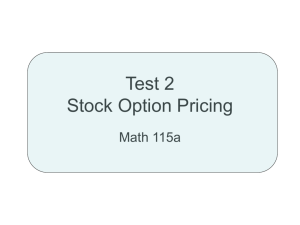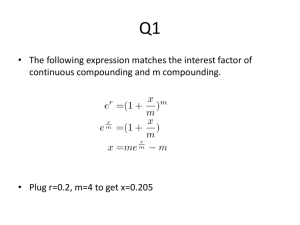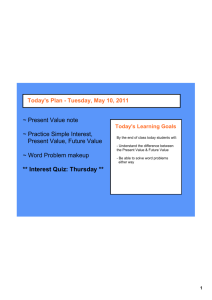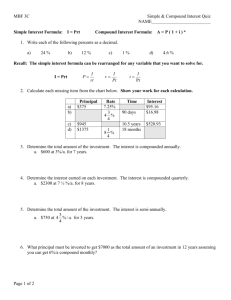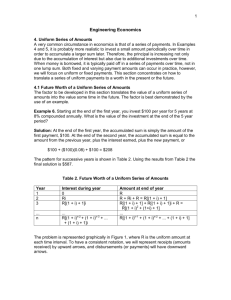INTERNAL RATE OF RETURN
advertisement
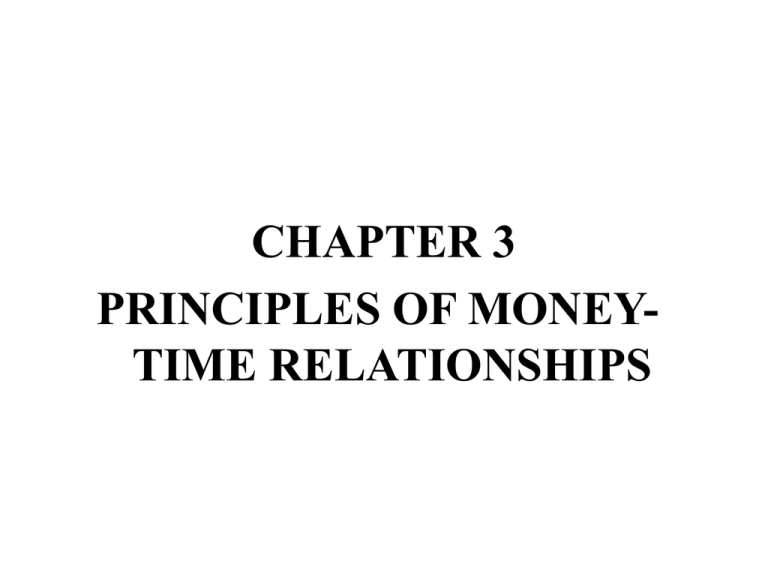
CHAPTER 3
PRINCIPLES OF MONEYTIME RELATIONSHIPS
Objectives Of This Chapter
Describe the return to capital in the form
of interest
Illustrate how basic equivalence
calculation are made with respect to the
time value of capital in Engineering
Economy
Capital
• Capital refers to wealth in the form of money or
property that can be used to produce more wealth
• Types of Capital
– Equity capital is that owned by individuals who
have invested their money or property in a
business project or venture in the hope of
receiving a profit.
– Debt capital, often called borrowed capital, is
obtained from lenders (e.g., through the sale of
bonds) for investment.
Financing
Definition
Instrument Description
• Bond • Promise to
pay
principle &
interest;
• Debt
financing
• Borrow
money
• Equity
financing
Exchange
• Sell partial • Stock •Exchange
of
sharesfor
ownership of
money
stock for
company;
shares
of
of
ownership
stock
as
company;
proof of
partial
ownership
Time Value of Money
• Time Value of Money
• Money can “make” money if Invested
• The change in the amount of money
over a given time period is called the
time value of money
• The most important concept in
engineering economy
Interest Rate
• INTEREST - THE AMOUNT PAID TO USE MONEY.
RENTAL FEE PAID FOR THE USE OF SOMEONE ELSES MONEY
– INVESTMENT
• INTEREST = VALUE NOW - ORIGINAL AMOUNT
– LOAN
• INTEREST = TOTAL OWED NOW - ORIGINAL AMOUNT
• INTEREST RATE - INTEREST PER TIME UNIT
INTEREST PER TIME UNIT
INTEREST RATE
ORIGINAL AMOUNT
Determination of Interest Rate
Interest
Rate
Money Supply
MS1
ie
Money Demand
Quantity of Money
Simple and Compound Interest
•Two “types” of interest calculations
•Simple Interest
•Compound Interest
•Compound Interest is more common
worldwide and applies to most analysis
situations
Simple Interest
• Simple Interest is calculated on the principal
amount only
•Easy (simple) to calculate
•Simple Interest is:
•(principal)(interest rate)(time); $I = (P)(i)(n)
•Borrow $1000 for 3 years at 5% per year
•Let “P” = the principal sum
•i = the interest rate (5%/year)
•Let N = number of years (3)
•Total Interest over 3 Years...
Compound Interest
•Compound Interest is much different
•Compound means to stop and compute
•In this application, compounding means to
compute the interest owed at the end of the
period and then add it to the unpaid
balance of the loan
•Interest then “earns interest”
Compound Interest: An Example
•Investing $1000 for 3 year at 5% per year
•P0 = $1000, I1 = $1,000(0.05) = $50.00
•P1 = $1,000 + 50 = $1,050
•New Principal sum at end of t = 1: = $1,050.00
•I2 = $1,050(0.05) = $52.50
•P2=1050 + 52.50 = $1102.50
•I3 = $1102.50(0.05) = $55.125 = $55.13
•At end of year 3 =1102.50 + 55.13 = $1157.63
Parameters and Cash Flows
•Parameters
•First cost (investment amounts)
•Estimates of useful or project life
•Estimated future cash flows (revenues and
expenses and salvage values)
•Interest rate
•Cash Flows
•Estimate flows of money coming into the firm – revenues
salvage values, etc. (magnitude and timing) – positive cash
flows--cash inflows
•Estimates of investment costs, operating costs, taxes paid –
negative cash flows -- cash outflows
Cash Flow Diagramming
• Engineering Economy has developed a
graphical technique for presenting a problem
dealing with cash flows and their timing.
•Called a CASH FLOW DIAGRAM
•Similar to a free-body diagram in statics
• First, some important TERMS . . . .
Terminology and Symbols
• P = value or amount of money at a time
designated as the present or time 0.
•F = value or amount of money at some future time.
•A = series of consecutive, equal, end-of-period
amounts of money.
•n = number of interest periods; years
•i = interest rate or rate of return per time period;
percent per year, percent per month
• t = time, stated in periods; years, months, days,
etc
The Cash Flow Diagram: CFD
• Extremely valuable analysis tool
• Graphical Representation on a time scale
•Does not have to be drawn “to exact scale”
•But, should be neat and properly labeled
•Assume a 5-year problem
END OF PERIOD Convention
•A NET CASH FLOW is
• Cash Inflows – Cash Outflows (for a
given time period)
• We normally assume that all cash flows
occur:
•At the END of a given time period
•End-of-Period Assumption
EQUIVALENCE
•You travel at 68 miles per hour
•Equivalent to 110 kilometers per hour
•Thus:
•68 mph is equivalent to 110 kph
•Using two measuring scales
•Is “68” equal to “110”?
•No, not in terms of absolute numbers
•But they are “equivalent” in terms of the two
measuring scales
ECONOMIC EQUIVALENCE
•Economic Equivalence
•Two sums of money at two different points
in time can be made economically
equivalent if:
•We consider an interest rate and,
•No. of Time periods between the two
sums
Equality in terms of Economic Value
More on Economic Equivalence Concept
• Five plans are shown that will pay off a loan of
$5,000 over 5 years with interest at 8% per year.
•Plan1. Simple Interest, pay all at the end
•Plan 2. Compound Interest, pay all at the end
•Plan 3. Simple interest, pay interest at end of each year.
Pay the principal at the end of N = 5
•Plan 4. Compound Interest and part of the principal each
year (pay 20% of the Prin. Amt.)
• Plan 5. Equal Payments of the compound interest and
principal reduction over 5 years with end of year
payments
Plan 1 @ 8% Simple Interest
• Simple Interest: Pay all at end on $5,000 Loan
Plan 2 Compound Interest 8%/yr
• Pay all at the End of 5 Years
Plan 3: Simple Interest Paid Annually
• Principal Paid at the End (balloon Note)
Plan 4 Compound Interest
• 20% of Principal Paid back annually
Plan 5 Equal Repayment Plan
• Equal Annual Payments (Part Principal and Part
Interest
Conclusion
•The difference in the total amounts
repaid can be explained (1) by the
time value of money, (2) by simple or
compound interest, and (3) by the
partial repayment of principal prior to
year 5.
Finding Equivalent Values of Cash
Flows- Six Scenarios
• Given a:
• Find its:
Present sum of money
Equivalent future value
Future sum of money
Equivalent present value
Uniform end-of-period series Equivalent present value
Present sum of money
Equivalent uniform end-of-period series
Uniform end-of-period series Equivalent future value
Future sum of money
Equivalent uniform end-of-period series
26
Derivation by Recursion: F/P factor
•
•
•
•
F1 = P(1+i)
F2 = F1(1+i)…..but:
F2 = P(1+i)(1+i) = P(1+i)2
F3 =F2(1+i) =P(1+i)2 (1+i)
= P(1+i)3
In general:
F
n
P
0
FN = P(1+i)n
FN = P(F/P,i%,n)
…
…
…
….
N
Present Worth Factor from F/P
• Since FN = P(1+i)n
• We solve for P in terms of FN
• P = F{1/ (1+i)n} = F(1+i)-n
• Thus:
P = F(P/F,i%,n) where
(P/F,i%,n) = (1+i)-n
An Example
• How much would you have to deposit now into an
account paying 10% interest per year in order to have
$1,000,000 in 40 years?
• Assumptions: constant interest rate; no additional
deposits or withdrawals
Solution:
P= 1000,000 (P/F, 10%, 40)=...
29
Uniform Series Present Worth and Capital
Recovery Factors
• Annuity Cash Flow
P = ??
1
2
3
…………..
..
0
$A per period
..
n-1
n
Uniform Series Present Worth and Capital
Recovery Factors
• Write a Present worth expression
1
1
1
1
P A
..
1
2
n 1
n
(1 i)
(1 i)
(1 i) (1 i)
[1]
1
P
1
1
1
A
..
[2]
2
3
n
n 1
1 i
(1 i) (1 i)
(1 i) (1 i)
Uniform Series Present Worth and
Capital Recovery Factors
• Setting up the subtraction
1
P
1
1
1
A
..
2
3
n
n 1
1 i
(1
i
)
(1
i
)
(1
i
)
(1
i
)
1
1
1
1
- P A (1 i)1 (1 i)2 .. (1 i)n1 (1 i)n
=
1
i
1
P A
n 1
1 i
(1 i )
(1 i )
[2]
[1]
[3]
Uniform Series Present Worth and
Capital Recovery Factors
• Simplifying Eq. [3] further
i
1
1
P A
n 1
1 i
(1
i
)
(1
i
)
P / A i %, n factor
(1 i)n 1
P A
for i 0
n
i(1 i)
The present worth point of
an annuity cash flow is
always one period to the
left of the first A amount
i (1 i ) n
A P
n
(1
i
)
1
A/P,i%,n factor
Section 3.9 Lotto Example
• If you win $5,000,000 in the California lottery, how
much will you be paid each year? How much money
must the lottery commission have on hand at the time of
the award? Assume interest = 3%/year.
• Given: Jackpot = $5,000,000, N = 19 years (1st payment
immediate), and i = 3% year
• Solution: A = $5,000,000/20 payments =
$250,000/payment (This is the lottery’s calculation
of A
P = $250,000 + $250,000(P | A, 3%, 19)
P = $250,000 + $3,580,950 = $3,830,950
34
Sinking Fund and Series Compound
amount factors (A/F and F/A)
• Annuity Cash Flow
Find $A given the
Future amt. - $F
$A per period
…………..
0
1
PF
n
(1
i
)
i(1 i)n
A P
n
(1
i
)
1
$F
i
A F
n
(1
i
)
1
N
(1 i ) n 1
F=A
i
Example - Uniform Series Capital
Recovery Factor
• Suppose you finance a $10,000 car over 60
months at an interest rate of 1% per month. How
much is your monthly car payment?
• Solution:
A = $10,000 (A | P, 1%, 60) = $222 per month
36
Example: Uniform Series Compound
Amount Factor
• Assume you make 10 equal annual deposits of $2,000
into an account paying 5% per year. How much is in
the account just after the 10th deposit? 12.5779
• Solution:
• F= $2,000 (F|A, 5%, 10) = $25,156
• Again, due to compounding, F>NxA when i>0%.
37
An Example
• Recall that you would need to deposit $22,100 today
into an account paying 10% per year in order to have
$1,000,000 40 years from now. Instead of the single
deposit, what uniform annual deposit for 40 years
would also make you a millionaire?
• Solution:
A = $1,000,000 (A | F, 10%, 40) = $
38
Basic Setup for Interpolation
•Work with the following basic relationships
Estimating for i = 7.3%
•
Form the following relationships
Interest Rates that vary over time
• In practice – interest rates do not stay the same
over time unless by contractual obligation.
• There can exist “variation” of interest rates
over time – quite normal!
• If required, how do you handle that situation?
41
Section 3.12 Multiple Interest Factors
• Some situations include multiple unrelated sums
or series, requiring the problem be broken into
components that can be individually solved and
then re-integrated. See page 93.
• Example: Problem 3-95
• What is the value of the following CFD?
42
Problem 3-95 Solution
• F1 = -$1,000(F/P,15%,1) - $1,000 = -$2,150
• F2 = F 1 (F/P,15%,1) + $3,000 = $527.50
• F4 = F 2 (F/P,10%,1)(F/P,6%,1) = $615.07
43
Arithmetic Gradient Factors
• An arithmetic (linear) Gradient is a cash flow
series that either increases or decreases by a
contestant amount over n time periods.
•A linear gradient is always comprised of TWO
components:
•The Gradient component
•The base annuity component
•The objective is to find a closed form expression
for the Present Worth of an arithmetic gradient
Linear Gradient Example
A1+n-1G
A1+n-2G
• Assume the following:
A1+2G
A1+G
0
1
2
3
n-1
N
This represents a positive, increasing arithmetic gradient
Present Worth: Gradient Component
• General CF Diagram – Gradient Part Only
(n-1)G
3G
1G
(n-2)G
2G
0G
We want the PW at time t = 0 (2 periods to the left of 1G)
0
1
2
3
4
………..
n-1
n
To Begin- Derivation of P/G,i%,n
P G ( P / F , i %, 2) 2G ( P / F , i%, 2) ...
...+ [(n-2)G](P/F,i,n-1)+[(n-1)G])P/F,i,n)
P G{( P / F , i %, 2) 2( P / F , i%, 2) ...
...+ [(n-2)](P/F,i,n-1)+[(n-1)])P/F,i,n)}
1
2
n-2
n-1
P=G
...
2
3
n-1
n
(1+i)
(1+i)
(1+i) (1+i)
Multiply both sides by (1+i)
Subtracting [1] from [2]…..
1
2
n-2
n-1
P(1+i) =G
...
1
2
n-2
n-1 2
(1+i)
(1+i)
(1+i) (1+i)
1
-
1
2
n-2
n-1
P=G
...
2
3
n-1
n
(1+i)
(1+i)
(1+i) (1+i)
G (1 i) 1
N
P=
N
N
i i(1 i)
(1 i)
N
( P / G, i%, N ) factor
1
The A/G Factor
• Convert G to an equivalent A
A G ( P / G, i, n)( A / P, i, n)
N
G (1 i) 1
N
P=
N
N
i i(1 i)
(1 i)
A/G,i,n =
i(1 i)
N
(1 i) 1
1
n
G
N
i (1 i) 1
N
Gradient Example
$700
$600
$500
$400
$300
$200
$100
0
1
2
3
4
5
6
7
•PW(10%)Base Annuity = $379.08
•PW(10%)Gradient Component= $686.18
•Total PW(10%) = $379.08 + $686.18
•Equals $1065.26
50
Geometric Gradients
• An arithmetic (linear) gradient changes by a
fixed dollar amount each time period.
•A GEOMETRIC gradient changes by a fixed
percentage each time period.
•We define a UNIFORM RATE OF CHANGE (%) for
each time period
•Define “g” as the constant rate of change in
decimal form by which amounts increase or
decrease from one period to the next
Geometric Gradients: Increasing
• Typical Geometric Gradient Profile
•Let A1 = the first cash flow in the series
0
1
A1
2
3
4
……..
n-1
n
A1(1+g)
A1(1+g)2
A1(1+g)3
A1(1+g)n-1
Geometric Gradients: Starting
• Pg = The Aj’s time the respective (P/F,i,j) factor
•Write a general present worth relationship to
find Pg….
A1
A1 (1 g ) A1 (1 g )2
A1 (1 g )n1
Pg
...
1
2
3
(1 i)
(1 i)
(1 i)
(1 i) n
Now, factor out the A1 value and rewrite as..
Geometric Gradients
1
(1 g )1 (1 g ) 2
(1 g ) n1
Pg A1
...
2
3
n
(1 i)
(1 i)
(1 i) (1 i)
Multuply both sides by
(1)
(1+g)
to create another equation
(1+i)
(1+g)
(1+g) 1
(1 g )1 (1 g ) 2
(1 g ) n1 (2)
Pg
A1
...
2
3
(1+i)
(1+i) (1 i) (1 i)
(1 i)
(1 i) n
Subtract (1) from (2) and the result is…..
Geometric Gradients
n
1+g
(1
g
)
1
Pg
1 A1
n 1
1 i
1+i
(1 i)
Solve for Pg and simplify to yield….
1 g n
nA1
P
1
g
1 i
(1 i)
Pg A1
gi
ig
For the case i = g
Geometric Gradient: Example
•Assume maintenance costs for a particular
activity will be $1700 one year from now.
•Assume an annual increase of 11% per year over
a 6-year time period.
•If the interest rate is 8% per year, determine the
present worth of the future expenses at time t =
0.
•First, draw a cash flow diagram to represent the
model.
Geometric Gradient Example (+g)
•g = +11% per period; A1 = $1700; i = 8%/yr
0
1
$1700
2
3
4
5
6
7
$1700(1.11)1
$1700(1.11)2
$1700(1.11)3
PW(8%) = ??
$1700(1.11)5
Example: i unknown
• Assume on can invest $3000 now in a venture in
anticipation of gaining $5,000 in five (5) years.
•If these amounts are accurate, what interest rate
equates these two cash flows?
$5,000
0
1
2
3
4
5
•F = P(1+i)n
$3,000
•(1+i)5 = 5,000/3000 = 1.6667
•(1+i) = 1.66670.20
•i = 1.1076 – 1 = 0.1076 = 10.76%
Unknown Number of Years
• Some problems require knowing the number of
time periods required given the other parameters
•Example:
•How long will it take for $1,000 to double in
value if the discount rate is 5% per year?
Fn = $2000
•Draw the cash flow diagram as….
i = 5%/year; n is unknown!
0
1
P = $1,000
2
...
. . . …….
n
Unknown Number of Years
Fn = $2000
• Solving we have…..
0
1
2
...
. . . …….
n
P = $1,000
•(1.05)x = 2000/1000
•Xln(1.05) =ln(2.000)
•X = ln(1.05)/ln(2.000)
•X = 0.6931/0.0488 = 14.2057 yrs
•With discrete compounding it will take 15 years
Section 3.16.
Nominal and Effective Interest Rates
• Nominal interest (r) = interest compounded more than
one interest period per year but quoted on an annual
basis.
• Example: 16%, compounded quarterly
• Effective interest (i) = actual interest rate earned or
charged for a specific time period.
• Example: 16%/4 = 4% effective interest for each of the
four quarters during the year.
61
Relationship
• Relation between nominal interest and effective
interest: i=(1+r/M)M -1, where
• i = effective annual interest rate
• r = nominal interest rate per year
• M = number of compounding periods per year
• r/M = interest rate per interest period
62
Nominal and Effective Interest Rates –Examples
• Find the effective interest rate per year at a nominal rate
of 18% compounded (1) quarterly, (2) semiannually,
and (3) monthly.
• (1) Quarterly compounding; i=(1+0.18/4)4 -1=0.1925 or
19.25%
• (2) Semiannual compounding; i=(1+0.18/2)2 -1=0.1881
or 18.81%
• (3) Monthly compounding ...
63
Nominal and Effective Interest Rates –Example
• A credit card company advertises an A.P.R. of
16.9% compounded daily on unpaid balances.
What is the effective interest rate per year being
charged? r = 16.9% M = 365
• Solution:
ieff = (1+0.169/365)365 -1=0.184 or 18.4% per year
64
Nominal and Effective Interest Rates
• Two situations we’ll deal with in Chapter 3:
• (1) Cash flows are annual. We’re given r per year and
M. Procedure: find i/yr = (1+r/M)M-1 and
discount/compound annual cash flows at i/yr.
• (2) Cash flows occur M times per year. We’re given r
per year and M. Find the interest rate that corresponds
to M, which is r/M per time period (e.g., quarter,
month). Then discount/compound the M cash flows per
year at r/M for the time period given.
65
Example: 12% Nominal
Annual
semi-annual
Quartertly
Bi-monthly
Monthly
Weekly
Daily
Hourly
Minutes
seconds
No. of
Comp. Per.
1
2
4
6
12
52
365
8760
525600
31536000
EAIR
(Decimal)
0.1200000
0.1236000
0.1255088
0.1261624
0.1268250
0.1273410
0.1274746
0.1274959
0.1274968
0.1274969
EAIR
(per cent)
12.00000%
12.36000%
12.55088%
12.61624%
12.68250%
12.73410%
12.74746%
12.74959%
12.74968%
12.74969%
12% nominal for various compounding periods
66
Interest Problems with Compounding more
often than once per Year – Example A
• If you deposit $1,000 now, $3,000 four years from now followed
by five quarterly deposits decreasing by $500 per quarter at an
interest rate of 12% per year compounded quarterly, how much
money will you have in you account 10 years from now?
r/M = 3% per quarter and year 3.75 = 15th Quarter
P @yr. 3.75 = P qtr. 15
= 3000(P/A, 3%, 6) - 500(P/G, 3%, 6) = $9713.60
F yr. 10 = F qtr. 40
= 9713.60(F/P, 3%, 25) + 1000(F/P, 3%, 40) =
= $23,600.34
67
Interest Problems with Compounding more
often than once per Year – Example B
• If you deposit $1,000 now, $3,000 four years from
now, and $1,500 six years from now at an interest rate
of 12% per year compounded semiannually, how much
money will you have in your account 10 years from
now?
• i per year = (1+0.12/2)12-1 = 0.1236
• F = $1,000(F/P, 12.36%, 10) + $3,000(F/P, 12.36%, 6)
+$1,500(F/P, 12.36%, 4) or r/M = 6% per half-year
• F = 1000(F/P, 6%, 20) + 3000(F/P, 6%, 12)+ 1500(F/P, 6%, 8)
• = $11,634.50
68
Derivation of Continuous Compounding
• We can state, in general terms for the EAIR:
r m
i (1 ) 1
m
Now, examine the impact of letting “m” approach
infinity.
69
Derivation of Continuous Compounding
• We re-define the general form as:
r m
r
(1
) 1 1
m
m
m
r
r
1
•From the calculus of limits there is an important limit that
is quite useful.
h
1
lim 1 e 2.71828
h
h
m
r r
lim 1
e,
m
m
ieff.= er – 1
70
Derivation of Continuous Compounding
•
Example:
• What is the true, effective annual interest rate
if the nominal rate is given as:
– r = 18%, compounded continuously
Solve e0.18 – 1 = 1.1972 – 1 = 19.72%/year
The 19.72% represents the MAXIMUM effective
interest rate for 18% compounded anyway you
choose!
71
Example
•
An investor requires an effective return of at least
15% per year. What is the minimum annual nominal
rate that is acceptable if interest on his investment is
compounded continuously?
• Solution:
er – 1 = 0.15
er = 1.15
ln(er) = ln(1.15)
r = ln(1.15) = 0.1398 = 13.98%
72

